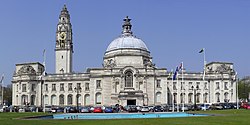City Hall, Cardiff
Municipal building in Cardiff, Wales From Wikipedia, the free encyclopedia
Municipal building in Cardiff, Wales From Wikipedia, the free encyclopedia
City Hall (Welsh: Neuadd y ddinas) is a municipal building in Cardiff, Wales, UK. It serves as Cardiff's centre of local government. It was built as part of the Cathays Park civic centre development and opened in October 1906. Built of Portland stone, it is an important early example of the Edwardian Baroque style. It is a Grade I listed building.[3]
| Cardiff City Hall | |
|---|---|
Neuadd y ddinas | |
 | |
 | |
| General information | |
| Architectural style | Edwardian Baroque style |
Listed Building – Grade I | |
| Official name | Cardiff City Hall |
| Designated | 25 January 1966 |
| Reference no. | 13744[1] |
| Town or city | Cardiff |
| Country | Wales |
| Coordinates | 51°29′07″N 03°10′43″W |
| Completed | 1906 |
| Cost | £129,708[2] |
| Client | Corporation of Cardiff |
| Design and construction | |
| Architect(s) |
|

The complex was commissioned to replace Cardiff's fourth town hall on the western side of St Mary's Street, which was completed in 1853.[4] Following a design competition, the firm of Lanchester, Stewart and Rickards was selected to design the city's fifth town hall and adjacent law courts in the Edwardian Baroque style.[3] The contractor, E. Turner and Sons, used the world's first all-electrically operated building site, including eight 5-ton cranes to lift the stone blocks. The total building cost was £129,708 (with the concurrently-built courts costing £96,583).[2] As Cardiff received its city charter in 1905 while construction was underway, the current building is known as City Hall. The new building was officially opened by Lord Bute on 29 October 1906.[5]
The distinctive clock tower is 59 m (194 ft) in height and has a 3.7 m-diameter (12 ft) gilded dial on each of its four faces. The clock mechanism includes an hour bell and four quarter bells which are each inscribed with mottoes in English or Welsh.[6]
In front of the entrance portico is a rectangular pool with fountains. The fountains were created to mark the investiture of Prince Charles as Prince of Wales in July 1969.[6]
On the southern side of the building are two memorials: the memorial on the right is dedicated to victims of the Second World War while the one on the left is dedicated to the Polish soldiers, airmen and sailors who gave their lives during that war.[7]
The first floor landing of City Hall is decorated with statues in Pentelicon marble of famous figures from Welsh history. These were funded by a gift from David Alfred Thomas, 1st Viscount Rhondda; the individuals commemorated were decided by a competition in the Western Mail newspaper. The Marble Hall with completed statues was unveiled by David Lloyd George, then Secretary of State for War, on 27 October 1916.[8]
The figures portrayed are as follows:
In July 2020, Cardiff Council voted to remove the marble statue of Sir Thomas Picton, on account of his links to slavery.[9][10]

This room has hosted royalty, international statesmen and diplomats, and can seat 500 diners. It is used for various ceremonies, conferences and events during the year. It is decorated with mouldings picked out in gold leaf, of mermaids and other sea creatures. Three large bronze chandeliers are contemporary to the original architects' design.[6]

This is located above the main entrance portico and directly below the main dome of the building. Hanging from the dome is a bronze chandelier designed by Edwin Alfred Rickards. The arrangement is unusual in that the seating is set in a circular pattern, whereas normally British council chambers have semicircular seating. The chamber was designed to host Cardiff's Council meetings (which have subsequently been relocated to County Hall in the Atlantic Wharf area). The dome of City Hall is supported by four massive pillars of Italian marble with bronze Ionic capitals. The chamber is paneled throughout in oak. The plaster work is by G.P. Bankart and the stained glass window depicts a personification of the City of Cardiff by Alfred Garth Jones, dated 1905.[6]
The cover of the Catatonia single "Mulder and Scully" has a UFO above the building similar to the movie poster for Independence Day.[11]
Seamless Wikipedia browsing. On steroids.
Every time you click a link to Wikipedia, Wiktionary or Wikiquote in your browser's search results, it will show the modern Wikiwand interface.
Wikiwand extension is a five stars, simple, with minimum permission required to keep your browsing private, safe and transparent.